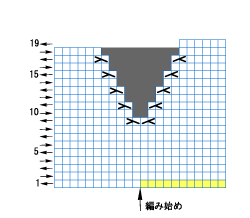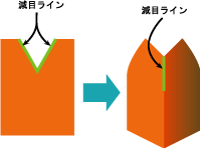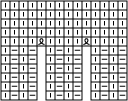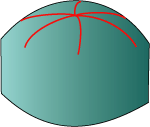| Decreasing and increasing in the middle of fabric | ||
| Decreasing and increasing in the middle of fabric | ||
Charts is destined to be drawn on the flat surface. Because of this essential restriction, it is by its nature difficult to represent three dimensional fabrics with charts. There are the fabrics which are easy to be knit and represented with text patterns, but looks complex while they are represented with charts. You have to understand how they are extended to the charts. The chart below shows the fabric only decreasing in the middle of the rows.
 |  |
| The Chart | The Chart and The Fabric |
While working rows with decreasing the stitch, the fabric is folded and make itself three dimensional. The chart is extended by cutting off along the decreasing-line to represent on the flat surface.
The gray area in the above chart means the extended part in the chart.
The area doesn't exist in real fabric and the stitches on the both side are exactly continued.
Sometimes the Japanese text ![]() ,which means "work as the continuing rows", placed at the gap area to make it clear.
,which means "work as the continuing rows", placed at the gap area to make it clear.

The chart above shows the fabric which has stocking stitches in the upper side and k1-p1 rib stitches in the lower side. This chart intends to show the typical method increasing stitches a little at the changing row from rib stitch to stocking stitch. The idea of the method is only to make the stocking-stitch-fabric wider evenly, however, its chart looks quite complex as shown.
 |  |
| The Chart | The Fabric |
The chart above is a example of a hat. The figure is jagged and it indeed seems difficult to be knit. On the contrary, the way of knitting is very simple. While you are knitting round, you knit together six times a round evenly.
Copyright© 2001-2002 Tata&Tatao. All Rights Reserved.